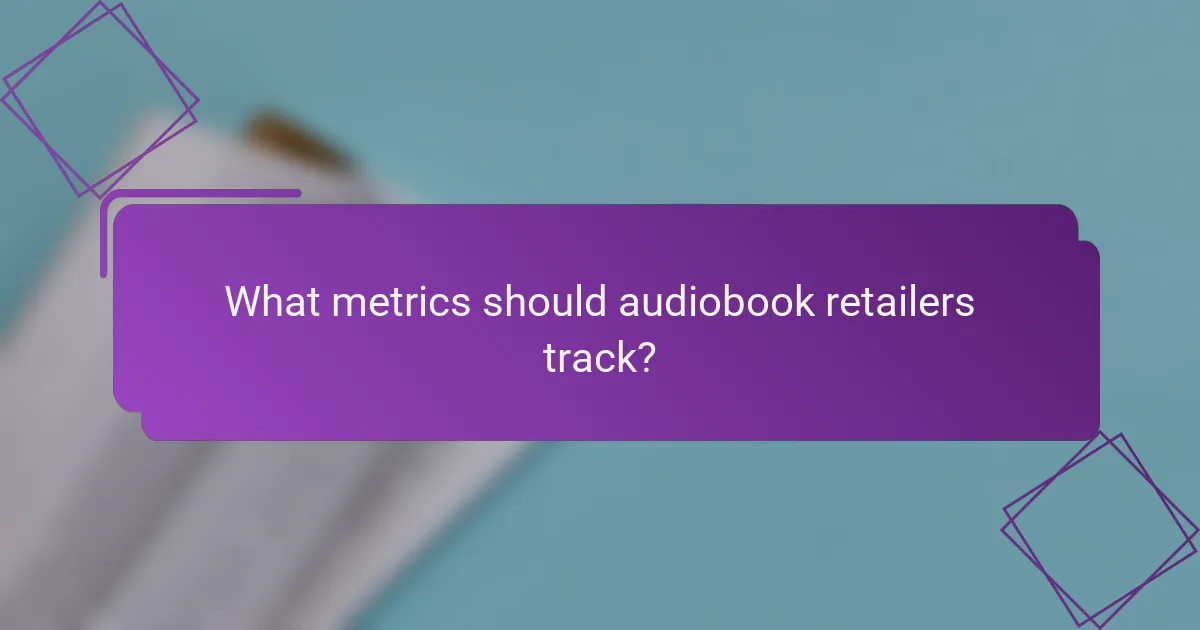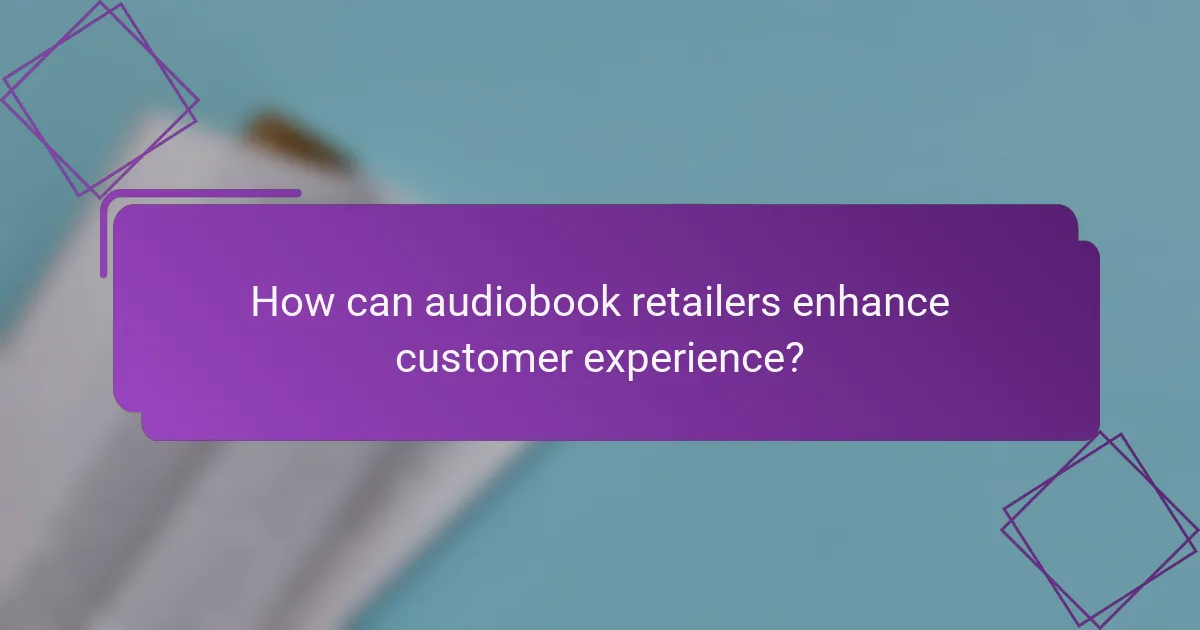Audiobook retailers can significantly enhance their market reach by implementing effective digital marketing strategies and optimizing their online presence. By engaging with audiences through targeted advertising, content marketing, and affiliate programs, retailers can attract new listeners while retaining existing customers. Choosing the right distribution platform is crucial, as it should align with the retailer’s target market and revenue objectives.

How can audiobook retailers maximize their reach?
Audiobook retailers can maximize their reach by employing a combination of digital marketing strategies, optimizing their online presence, and engaging with their audience through various channels. These methods help to attract new customers and retain existing ones, ultimately leading to increased sales and brand loyalty.
Utilizing social media advertising
Social media advertising is a powerful tool for audiobook retailers to reach a broader audience. Platforms like Facebook, Instagram, and TikTok allow targeted ads that can be tailored to specific demographics, interests, and behaviors, ensuring that promotional content reaches potential listeners effectively.
Consider using eye-catching visuals and engaging audio clips from audiobooks to capture attention. Setting a budget for ads and monitoring performance metrics can help refine strategies and improve return on investment.
Implementing SEO strategies
Search engine optimization (SEO) is essential for increasing visibility in search engine results. Audiobook retailers should focus on keyword research to identify terms potential customers use when searching for audiobooks, such as “best audiobooks” or “audiobook deals.”
Optimizing website content, including product descriptions and blog posts, can enhance search rankings. Regularly updating content and building backlinks from reputable sites can further improve SEO performance.
Leveraging email marketing campaigns
Email marketing remains an effective way to engage with customers and promote new releases or special offers. Audiobook retailers should build a subscriber list through their website and social media, offering incentives like exclusive content or discounts for sign-ups.
Crafting personalized email campaigns that highlight recommendations based on past purchases can enhance customer experience. Regular newsletters featuring new titles, author interviews, or industry news can keep subscribers engaged and informed.
Creating partnerships with influencers
Collaborating with influencers in the audiobook and literary communities can significantly expand reach. Influencers can introduce audiobooks to their followers through reviews, social media posts, or live readings, creating authentic connections with potential customers.
When selecting influencers, consider their audience demographics and engagement rates to ensure alignment with your target market. Offering free audiobooks for review or hosting joint giveaways can incentivize partnerships and boost visibility.
Offering promotions and discounts
Promotions and discounts can attract new customers and encourage repeat purchases. Audiobook retailers might consider offering limited-time discounts, bundle deals, or loyalty programs that reward frequent buyers.
Highlighting these promotions through social media, email newsletters, and the website can create urgency and drive sales. Be mindful of the timing of promotions, aligning them with holidays or special events to maximize impact.

What are effective marketing strategies for audiobook retailers?
Effective marketing strategies for audiobook retailers focus on increasing visibility and driving sales through targeted approaches. Utilizing content marketing, targeted advertising, and affiliate programs can significantly enhance reach and engagement with potential listeners.
Content marketing through blogs
Content marketing via blogs allows audiobook retailers to establish authority and attract a dedicated audience. By creating informative articles related to audiobooks, such as reviews, author interviews, or genre explorations, retailers can engage readers and encourage them to explore their offerings.
Consider incorporating SEO best practices to enhance visibility in search engines. Use relevant keywords, optimize for mobile, and share content on social media to drive traffic. Regularly updating the blog with fresh content can keep the audience engaged and returning for more.
Targeted ads on platforms like Facebook
Targeted advertising on platforms like Facebook enables audiobook retailers to reach specific demographics interested in their products. By utilizing audience insights, retailers can create tailored ads that resonate with potential customers based on their interests and behaviors.
Setting a budget for ads is crucial; retailers can start with a modest daily spend and adjust based on performance metrics. A/B testing different ad formats and messages can help identify what resonates best with the audience, maximizing return on investment.
Utilizing affiliate marketing programs
Affiliate marketing programs can expand an audiobook retailer’s reach by leveraging the influence of bloggers and content creators. By offering commissions for sales generated through affiliate links, retailers incentivize partners to promote their audiobooks to their audiences.
When setting up an affiliate program, ensure clear terms and competitive commission rates to attract quality affiliates. Regularly communicate with partners and provide them with promotional materials to enhance their marketing efforts, fostering a mutually beneficial relationship.

Which platforms are best for audiobook distribution?
Several platforms excel in audiobook distribution, each catering to different audiences and business models. The best choice depends on your target market, revenue goals, and distribution strategy.
Audible as a leading platform
Audible is widely recognized as the premier platform for audiobook distribution, boasting a vast library and a large subscriber base. It operates on a subscription model, allowing users to access a wide range of audiobooks for a monthly fee, which can lead to higher sales for authors and publishers.
When distributing through Audible, consider their royalty structure, which typically offers around 25% for exclusive titles and 40% for non-exclusive ones. This can significantly impact your earnings, so weigh the benefits of exclusivity against potential wider reach on other platforms.
Scribd for subscription models
Scribd offers a unique subscription model that includes audiobooks, eBooks, and other content, appealing to users who prefer an all-in-one service. This platform can be particularly beneficial for authors looking to reach a diverse audience who enjoys various media formats.
When using Scribd, keep in mind that the revenue share may differ from traditional sales models. Authors typically earn based on the number of pages read or listened to, which can vary widely. Therefore, it’s essential to promote your audiobook effectively to maximize engagement on this platform.
Kobo for eBook and audiobook integration
Kobo provides a seamless integration of eBooks and audiobooks, making it an attractive option for readers who enjoy both formats. This platform is particularly popular in Canada and Europe, offering authors a chance to tap into these markets.
When distributing through Kobo, consider their unique promotional tools and marketing opportunities, which can help increase visibility. Additionally, Kobo’s partnership with local libraries can enhance reach, allowing users to borrow audiobooks, thereby expanding your audience without direct sales pressure.

What metrics should audiobook retailers track?
Audiobook retailers should track key metrics that provide insights into sales performance, customer acquisition, and engagement. Focusing on these metrics helps optimize marketing strategies and improve overall profitability.
Sales conversion rates
Sales conversion rates measure the percentage of visitors who make a purchase. For audiobook retailers, this metric is crucial as it indicates how effectively the site turns potential customers into buyers. A typical conversion rate for e-commerce can range from 1% to 5%, but aiming for higher rates can significantly boost revenue.
To improve conversion rates, retailers should analyze user behavior on their platforms. Implementing A/B testing on landing pages, optimizing product descriptions, and ensuring a smooth checkout process can lead to better results. Regularly reviewing these rates can help identify trends and areas for improvement.
Customer acquisition costs
Customer acquisition cost (CAC) refers to the total expense incurred to acquire a new customer. This includes marketing expenses, promotional offers, and any other costs associated with attracting buyers. For audiobook retailers, keeping CAC low while maintaining high-quality leads is essential for profitability.
To calculate CAC, divide total marketing expenses by the number of new customers acquired in a specific period. Retailers should aim for a CAC that allows for a healthy return on investment, typically ensuring that the lifetime value of a customer is at least three times the CAC. Monitoring this metric helps in adjusting marketing strategies effectively.
Engagement rates on social media
Engagement rates on social media reflect how actively users interact with content related to audiobooks. This includes likes, shares, comments, and overall reach. High engagement rates can indicate a strong connection with the audience and can lead to increased sales.
To enhance engagement, audiobook retailers should create compelling content that resonates with their target audience. This could involve sharing excerpts, author interviews, or user-generated content. Tracking engagement metrics regularly can guide content strategy and help retailers understand what types of posts drive the most interaction.

How can audiobook retailers enhance customer experience?
Audiobook retailers can enhance customer experience by focusing on personalized interactions, efficient purchasing processes, and responsive support. These strategies create a more engaging and satisfying environment for users, ultimately leading to increased loyalty and sales.
Personalized recommendations
Personalized recommendations help audiobook retailers tailor their offerings to individual customer preferences. By analyzing user behavior, purchase history, and ratings, retailers can suggest titles that align with a listener’s interests, increasing the likelihood of additional purchases.
Implementing algorithms that consider factors like genre, author, and even listening speed can refine these recommendations. Retailers should also encourage user feedback on suggestions to continuously improve the accuracy of their recommendations.
Streamlined checkout processes
A streamlined checkout process minimizes friction during the purchase, enhancing customer satisfaction. Retailers should aim for a one-click purchase option, allowing users to buy audiobooks quickly without unnecessary steps.
Offering multiple payment options, such as credit cards, PayPal, and local payment methods, can cater to a wider audience. Additionally, ensuring that the checkout page is mobile-friendly is crucial, as many users shop via smartphones.
Responsive customer service
Responsive customer service is vital for addressing user inquiries and resolving issues promptly. Audiobook retailers should provide multiple channels for support, including live chat, email, and phone options, ensuring customers can reach out in their preferred way.
Implementing a comprehensive FAQ section can also help users find answers quickly, reducing the need for direct contact. Training customer service representatives to be knowledgeable about the product and empathetic towards user concerns can significantly enhance the overall experience.

What are the challenges audiobook retailers face?
Audiobook retailers encounter several challenges that can impact their market reach and profitability. Key issues include intense competition from streaming services, evolving consumer preferences, and the need for effective marketing strategies to stand out in a crowded market.
Competition from streaming services
Streaming services have significantly changed the audiobook landscape, providing consumers with affordable access to vast libraries. Many users prefer subscription models that offer unlimited listening for a fixed monthly fee, which can undermine traditional audiobook sales.
To compete, audiobook retailers should consider offering unique features such as exclusive content, curated lists, or personalized recommendations. Implementing flexible pricing strategies, like pay-per-listen options or bundled deals, can also attract customers who may be hesitant to commit to a subscription.
Retailers should focus on building a strong brand identity and community around their offerings. Engaging with listeners through social media, author events, and interactive content can foster loyalty and encourage word-of-mouth promotion, which is vital in a competitive environment.



